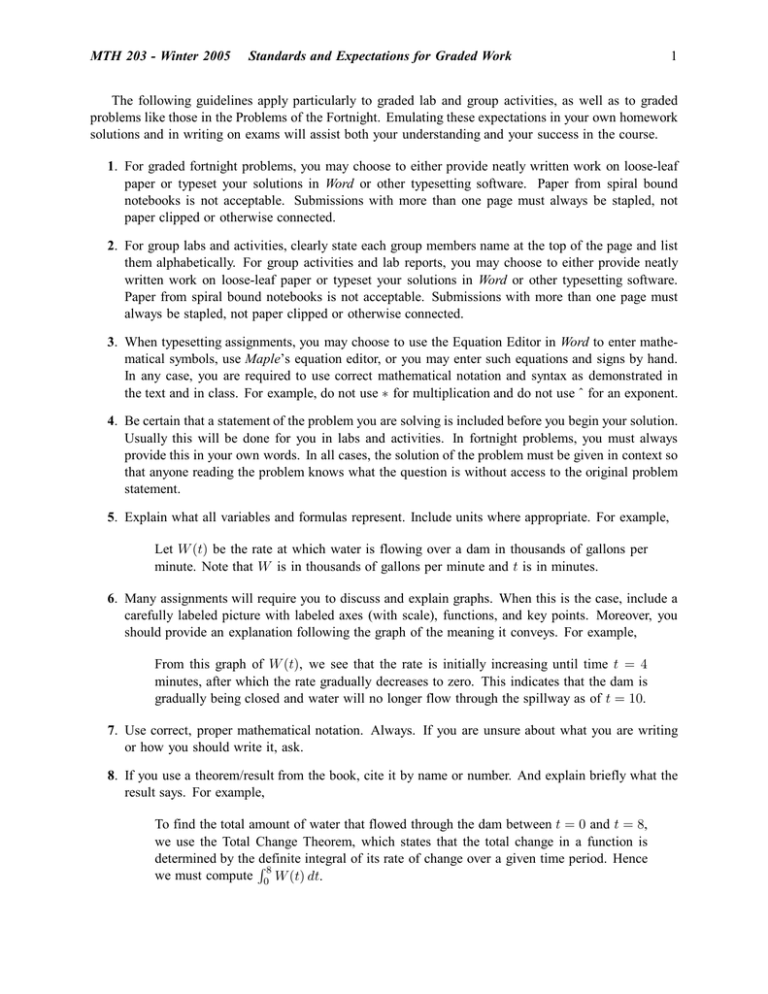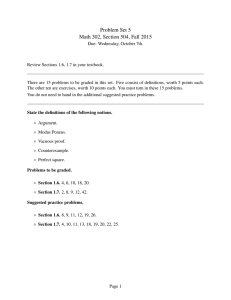MTH 203 - Winter 2005 Standards and Expectations for Graded Work 1
advertisement

MTH 203 - Winter 2005 Standards and Expectations for Graded Work 1 The following guidelines apply particularly to graded lab and group activities, as well as to graded problems like those in the Problems of the Fortnight. Emulating these expectations in your own homework solutions and in writing on exams will assist both your understanding and your success in the course. 1. For graded fortnight problems, you may choose to either provide neatly written work on loose-leaf paper or typeset your solutions in Word or other typesetting software. Paper from spiral bound notebooks is not acceptable. Submissions with more than one page must always be stapled, not paper clipped or otherwise connected. 2. For group labs and activities, clearly state each group members name at the top of the page and list them alphabetically. For group activities and lab reports, you may choose to either provide neatly written work on loose-leaf paper or typeset your solutions in Word or other typesetting software. Paper from spiral bound notebooks is not acceptable. Submissions with more than one page must always be stapled, not paper clipped or otherwise connected. 3. When typesetting assignments, you may choose to use the Equation Editor in Word to enter mathematical symbols, use Maple's equation editor, or you may enter such equations and signs by hand. In any case, you are required to use correct mathematical notation and syntax as demonstrated in the text and in class. For example, do not use ∗ for multiplication and do not use ^ for an exponent. 4. Be certain that a statement of the problem you are solving is included before you begin your solution. Usually this will be done for you in labs and activities. In fortnight problems, you must always provide this in your own words. In all cases, the solution of the problem must be given in context so that anyone reading the problem knows what the question is without access to the original problem statement. 5. Explain what all variables and formulas represent. Include units where appropriate. For example, Let W (t) be the rate at which water is flowing over a dam in thousands of gallons per minute. Note that W is in thousands of gallons per minute and t is in minutes. 6. Many assignments will require you to discuss and explain graphs. When this is the case, include a carefully labeled picture with labeled axes (with scale), functions, and key points. Moreover, you should provide an explanation following the graph of the meaning it conveys. For example, From this graph of W (t), we see that the rate is initially increasing until time t = 4 minutes, after which the rate gradually decreases to zero. This indicates that the dam is gradually being closed and water will no longer flow through the spillway as of t = 10. 7. Use correct, proper mathematical notation. Always. If you are unsure about what you are writing or how you should write it, ask. 8. If you use a theorem/result from the book, cite it by name or number. And explain briefly what the result says. For example, To find the total amount of water that flowed through the dam between t = 0 and t = 8, we use the Total Change Theorem, which states that the total change in a function is determined by the Rdefinite integral of its rate of change over a given time period. Hence 8 we must compute 0 W (t) dt. MTH 203 - Winter 2005 Standards and Expectations for Graded Work 2 9. Frequently your work will contain equations and mathematical symbols. Smaller examples of these may be given \in line" within a sentence; more complicated collections of these should be centered on separate lines as demonstrated below. Note particularly the explanatory sentence that precedes the computations. R8 2 To determine the value of the definite integral 0 W (t) dt, where W (t) = te−t , we use the method of u-substitution as follows: Z 8 Z 8 2 W (t) dt = te−t dt 0 0 Z −64 1 − eu du , using u = −t2 and du = −2t dt = 2 0 1 = − eu |u=−64 u=0 2 1 1 = − e−64 + . 2 2 (An appropriate discussion of the meaning of this number and relevant units would follow here.) 10. Finally, it is always essential that you use proper grammar, complete sentences, and correct spelling. Always proofread your work thoroughly.




